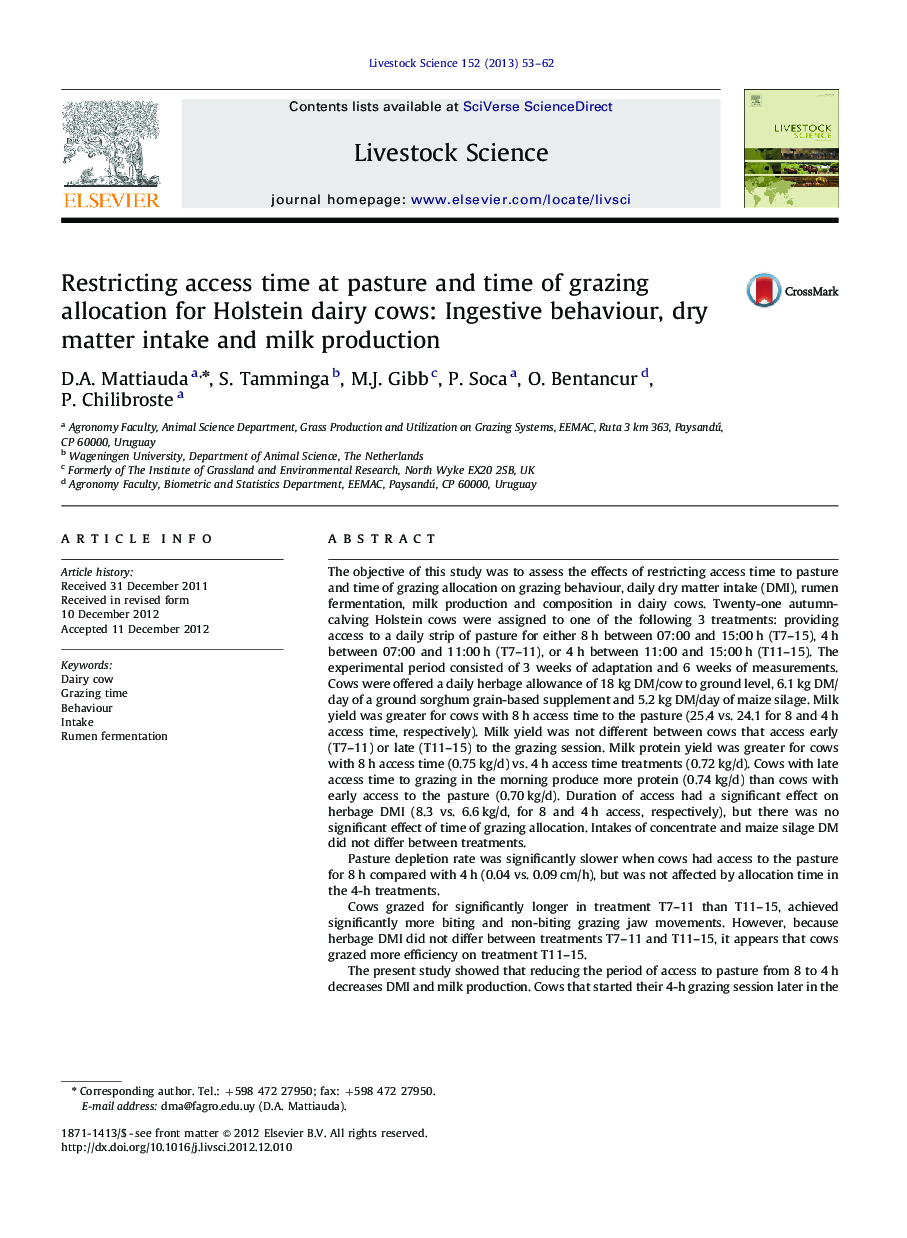| کد مقاله | کد نشریه | سال انتشار | مقاله انگلیسی | نسخه تمام متن |
|---|---|---|---|---|
| 2447406 | 1109496 | 2013 | 10 صفحه PDF | دانلود رایگان |

The objective of this study was to assess the effects of restricting access time to pasture and time of grazing allocation on grazing behaviour, daily dry matter intake (DMI), rumen fermentation, milk production and composition in dairy cows. Twenty-one autumn-calving Holstein cows were assigned to one of the following 3 treatments: providing access to a daily strip of pasture for either 8 h between 07:00 and 15:00 h (T7–15), 4 h between 07:00 and 11:00 h (T7–11), or 4 h between 11:00 and 15:00 h (T11–15). The experimental period consisted of 3 weeks of adaptation and 6 weeks of measurements. Cows were offered a daily herbage allowance of 18 kg DM/cow to ground level, 6.1 kg DM/day of a ground sorghum grain-based supplement and 5.2 kg DM/day of maize silage. Milk yield was greater for cows with 8 h access time to the pasture (25.4 vs. 24.1 for 8 and 4 h access time, respectively). Milk yield was not different between cows that access early (T7–11) or late (T11–15) to the grazing session. Milk protein yield was greater for cows with 8 h access time (0.75 kg/d) vs. 4 h access time treatments (0.72 kg/d). Cows with late access time to grazing in the morning produce more protein (0.74 kg/d) than cows with early access to the pasture (0.70 kg/d). Duration of access had a significant effect on herbage DMI (8.3 vs. 6.6 kg/d, for 8 and 4 h access, respectively), but there was no significant effect of time of grazing allocation. Intakes of concentrate and maize silage DM did not differ between treatments.Pasture depletion rate was significantly slower when cows had access to the pasture for 8 h compared with 4 h (0.04 vs. 0.09 cm/h), but was not affected by allocation time in the 4-h treatments.Cows grazed for significantly longer in treatment T7–11 than T11–15, achieved significantly more biting and non-biting grazing jaw movements. However, because herbage DMI did not differ between treatments T7–11 and T11–15, it appears that cows grazed more efficiency on treatment T11–15.The present study showed that reducing the period of access to pasture from 8 to 4 h decreases DMI and milk production. Cows that started their 4-h grazing session later in the morning (T11–15) produced more protein than cows that started earlier (T7–11), probably as a consequence of a larger bite mass and a tendency for higher intake rate. Rumen pH of cows grazing on treatment T11–15 declined faster than in cows on T7–11, which is in accordance with the higher VFA and ammonia rumen concentrations observed after the grazing session started.
Journal: Livestock Science - Volume 152, Issue 1, March 2013, Pages 53–62